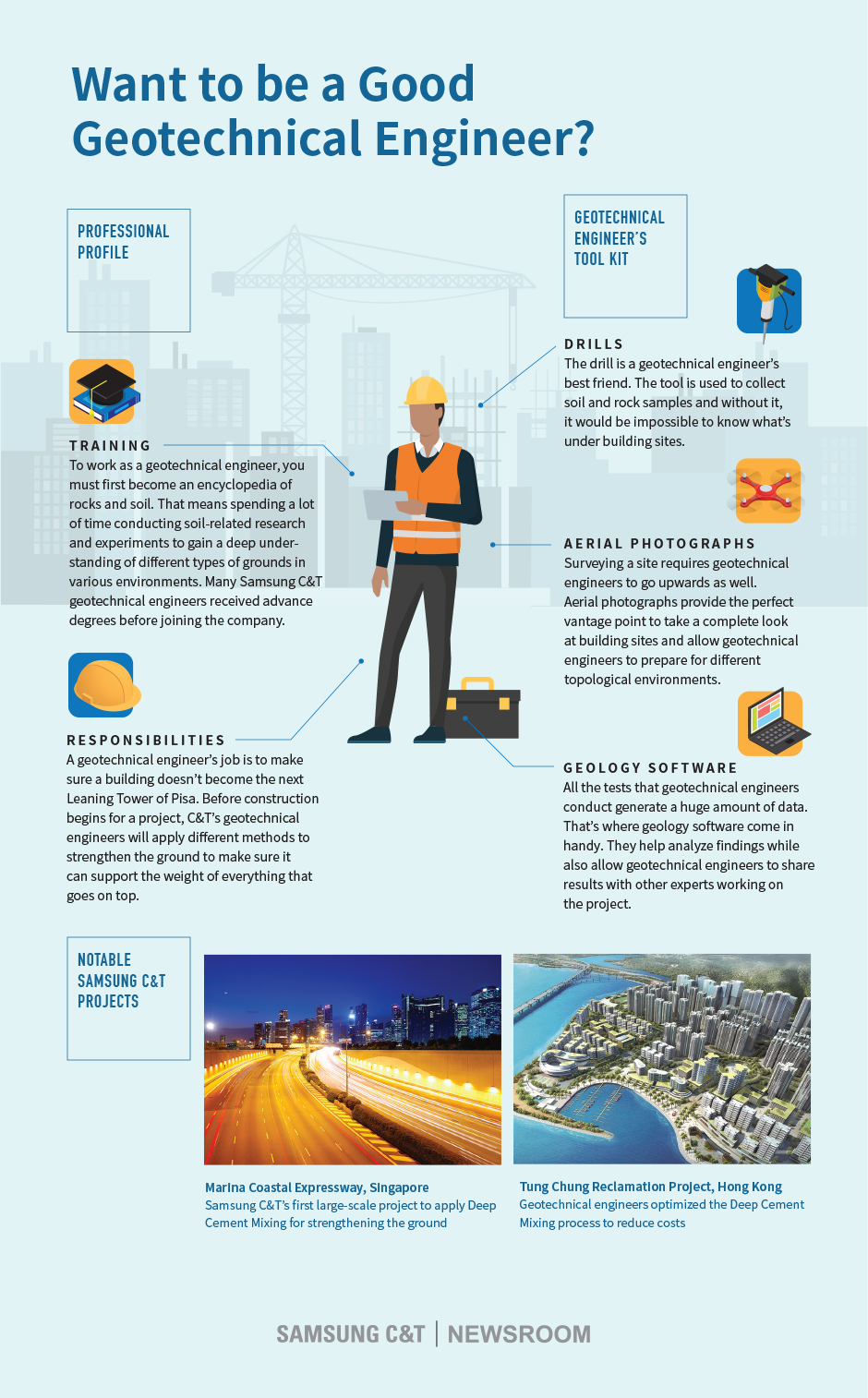Geotheta Fundamentals Explained
Geotheta Fundamentals Explained
Blog Article
Some Known Facts About Geotheta.
Table of ContentsThe Facts About Geotheta RevealedFacts About Geotheta UncoveredThe Basic Principles Of Geotheta Excitement About GeothetaThe Best Guide To Geotheta

They carry out website investigations, collect samples, execute laboratory examinations, and assess data to assess the viability of the ground for building and construction projects - Engineer of Record. Based on their findings, geotechnical engineers provide suggestions for structure layout, incline stability, keeping frameworks, and reduction of geotechnical dangers. They team up with various other specialists, such as architects, architectural engineers, and building teams, to guarantee that geotechnical factors to consider are incorporated right into the total job design and application
By evaluating the actions and residential properties of dirt and rock, they can determine prospective geotechnical risks such as landslides, soil settlement, or incline instability. Their proficiency aids prevent failings or crashes that can jeopardize lives and home. Here are some comprehensive tasks and duties of a geotechnical engineer: Site Investigation: Geotechnical engineers conduct site examinations to collect data on subsurface conditions.
They analyze the information to understand the properties and habits of the soil and rock, including their stamina, permeability, compaction qualities, and groundwater problems. Geotechnical Analysis and Layout: Geotechnical designers analyze the information gathered during site investigations to assess the stability and viability of the website for construction tasks. They execute geotechnical estimations and modeling to review variables such as birthing capability, settlement, incline security, lateral earth pressures, and groundwater circulation.
The Definitive Guide for Geotheta
Foundation Design: Geotechnical designers play an essential role in making foundations that can securely support the desired framework. They evaluate the dirt problems and lots demands to determine the ideal foundation kind, such as shallow structures (e.g., grounds), deep foundations (e.g (https://www.huntingnet.com/forum/members/geotheta.html)., piles), or specialized methods like dirt enhancement. They consider elements such as settlement limitations, birthing capacity, and soil-structure interaction to create optimum structure styles
They assess building and construction strategies, display site activities, and perform area examinations to verify that the style referrals are followed. If unexpected geotechnical issues emerge, they evaluate the circumstance and give suggestions for removal or modifications to the layout. Risk Evaluation and Mitigation: Geotechnical designers evaluate geotechnical dangers and risks connected with the task site, such as landslides, liquefaction, or soil disintegration.

Cooperation and Interaction: Geotechnical engineers work carefully with other specialists involved in a project, such as engineers, architectural engineers, and building and construction teams. Efficient interaction and collaboration are necessary to incorporate geotechnical factors to consider right into the total task layout and construction procedure. Geotechnical engineers give technological proficiency, response queries, and make sure that geotechnical needs are fulfilled.
Rumored Buzz on Geotheta
Right here are some kinds of geotechnical engineers: Foundation Designer: Structure engineers concentrate on creating and evaluating foundations for structures. They analyze the dirt problems, tons requirements, and website qualities to establish one of the most proper structure kind and design, such as superficial foundations, deep foundations, or specialized strategies like heap foundations.
They examine the factors affecting incline security, such as soil homes, groundwater problems, and incline geometry, and create techniques to stop slope failings and minimize threats. Earthquake Designer: Earthquake designers focus on assessing and making structures to stand up to seismic pressures. They evaluate the seismic hazard of a website, evaluate soil liquefaction capacity, and develop seismic design criteria to make sure the safety and resilience of frameworks during earthquakes.
They perform field screening, gather samples, and examine the gathered data to characterize the dirt residential or commercial properties, geologic developments, and groundwater problems at a website. Geotechnical Instrumentation Designer: Geotechnical instrumentation designers concentrate on monitoring and determining the behavior of soil, rock, and frameworks. They mount and preserve instrumentation systems that keep an eye on aspects such as dirt negotiation, groundwater degrees, incline motions, and structural displacements to evaluate efficiency and offer very early cautions of possible problems.
Excitement About Geotheta
They perform tests such as triaxial tests, loan consolidation tests, straight shear tests, and permeability my site tests to gather data for geotechnical analysis and layout. Geosynthetics Engineer: Geosynthetics engineers focus on the design and application of geosynthetic materials, such as geotextiles, geogrids, and geomembranes. They use these products to enhance soil stability, strengthen inclines, provide drain solutions, and control disintegration.
They tend to be investigative individuals, which suggests they're intellectual, reflective, and inquisitive. They are interested, methodical, rational, analytical, and rational. Some of them are likewise social, suggesting they're kind, charitable, cooperative, individual, caring, practical, compassionate, skillful, and friendly - Engineer of Record.
In the workplace setting, geotechnical designers make use of specialized software application tools to carry out calculations, produce styles, and assess information. They prepare reports, review project requirements, connect with customers and employee, and coordinate task activities. The office setting offers a conducive environment for study, evaluation, and partnership with other professionals associated with the project.
What Does Geotheta Mean?
They frequently check out project websites to perform site examinations, analyze geotechnical problems, and gather information for analysis. These check outs involve taking a trip to various places, in some cases in remote or challenging surfaces. Geotechnical engineers might carry out dirt sampling, conduct tests, and display building activities to make sure that the geotechnical facets of the project are being carried out correctly.
Geotechnical engineers additionally work in specialized geotechnical labs. In these centers, they perform experiments, carry out examinations on soil and rock examples, and assess the engineering residential or commercial properties of the products. Geotechnical research laboratory designers work extensively in these atmospheres, handling testing devices, running instruments, and taping information. They work together with various other lab team to guarantee accurate and trusted screening outcomes.
Report this page